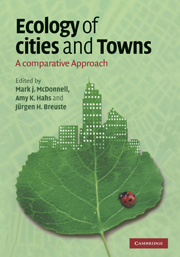Book contents
- Frontmatter
- Contents
- List of contributors
- Preface
- 1 Introduction: Scope of the book and need for developing a comparative approach to the ecological study of cities and towns
- Part I Opportunities and challenges of conducting comparative studies
- Part II Ecological studies of cities and towns
- 8 Responses of faunal assemblages to urbanisation: global research paradigms and an avian case study
- 9 Effect of urban structures on diversity of marine species
- 10 Comparative studies of terrestrial vertebrates in urban areas
- 11 The ecology of roads in urban and urbanising landscapes
- 12 Spatial pattern and process in urban animal communities
- 13 Invertebrate biodiversity in urban landscapes: assessing remnant habitat and its restoration
- 14 Arthropods in urban ecosystems: community patterns as functions of anthropogenic land use
- 15 Light pollution and the impact of artificial night lighting on insects
- 16 A comparison of vegetation cover in Beijing and Shanghai: a remote sensing approach
- 17 Vegetation composition and structure of forest patches along urban–rural gradients
- 18 Environmental, social and spatial determinants of urban arboreal character in Auckland, New Zealand
- 19 Carbon and nitrogen cycling in soils of remnant forests along urban–rural gradients: case studies in the New York metropolitan area and Louisville, Kentucky
- 20 Investigative approaches to urban biogeochemical cycles: New York metropolitan area and Baltimore as case studies
- Part III Integrating science with management and planning
- Part IV Comments and synthesis
- References
- Index
- Plate section
18 - Environmental, social and spatial determinants of urban arboreal character in Auckland, New Zealand
Published online by Cambridge University Press: 04 March 2010
- Frontmatter
- Contents
- List of contributors
- Preface
- 1 Introduction: Scope of the book and need for developing a comparative approach to the ecological study of cities and towns
- Part I Opportunities and challenges of conducting comparative studies
- Part II Ecological studies of cities and towns
- 8 Responses of faunal assemblages to urbanisation: global research paradigms and an avian case study
- 9 Effect of urban structures on diversity of marine species
- 10 Comparative studies of terrestrial vertebrates in urban areas
- 11 The ecology of roads in urban and urbanising landscapes
- 12 Spatial pattern and process in urban animal communities
- 13 Invertebrate biodiversity in urban landscapes: assessing remnant habitat and its restoration
- 14 Arthropods in urban ecosystems: community patterns as functions of anthropogenic land use
- 15 Light pollution and the impact of artificial night lighting on insects
- 16 A comparison of vegetation cover in Beijing and Shanghai: a remote sensing approach
- 17 Vegetation composition and structure of forest patches along urban–rural gradients
- 18 Environmental, social and spatial determinants of urban arboreal character in Auckland, New Zealand
- 19 Carbon and nitrogen cycling in soils of remnant forests along urban–rural gradients: case studies in the New York metropolitan area and Louisville, Kentucky
- 20 Investigative approaches to urban biogeochemical cycles: New York metropolitan area and Baltimore as case studies
- Part III Integrating science with management and planning
- Part IV Comments and synthesis
- References
- Index
- Plate section
Summary
Introduction
To date, nearly all vegetation studies in New Zealand have been carried out in pristine to semi-natural systems. Thus, urban ecology in New Zealand is in its infancy as compared with the centuries of observation, documentation and mapping of vegetation, biotopes and natural history in urban areas of Europe (Gilbert,1989; Breuste et al., 1998; Sukopp, 2002; Breuste, Chapter 21; Florgård, Chapter 22; Wittig, Chapter 30) and 30-plus years of study in North America (Zipperer and Guntenspergen, Chapter 17). The relatively few studies of urban vegetation in the New World have typically focused on remnant natural systems enveloped by residential and commercial dwellings (Airola and Buchholz, 1984; Rudnicky and McDonnell, 1989; Kuschel, 1990; Molloy, 1995; McDonnell et al., 1997). Accordingly, there is a distinction to be made between the ecology of remnant primary ecosystems (those that retain at least some thread of biological and pedological continuity with the primeval system) and the ecology of synthetic or spontaneous recombinant systems on anthropogenic substrates (i.e. most vegetation in cities and towns). In New Zealand, we know quite a lot about natural forest, wetland and grassland vegetation, whether in National Parks or as remnants in cities (Wardle, 1991); but little about recombinant communities of cultural landscapes (that is, human-inhabited landscapes in the sense of Nassauer (1997)). They have been traditionally shunned in New Zealand because they almost totally comprise exotic, planted and/or weedy species.
- Type
- Chapter
- Information
- Ecology of Cities and TownsA Comparative Approach, pp. 287 - 307Publisher: Cambridge University PressPrint publication year: 2009
- 5
- Cited by

